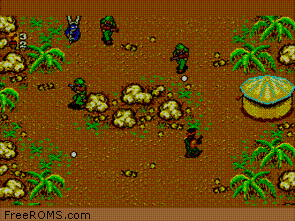
Decades later, Eduardo Mello ported Ninja Princess to the ColecoVision, where it was unofficially released by Team Pixelboy, with a neatly updated interpretation of the cover art by Studio Cutepet. As usual for ports between the two technologically very similar systems, it is exactly the same. This variant was also published for MSX computers through Pony Canyon (dated June 1986). It certainly makes for a more deliberate pace, although it never gets slow or boring, outside of the rather arduous climbing stages. That also highlights the game’s one bigger flaw compared to its prime competitor, though: Sometimes the pacing can get a bit bumpy, when you have to keep walking on to trigger the next wave of foes, especially when you’ve retreated backwards during the last attack. Hostile ninjas tend to attack in huge groups, but it’s not quite the constant pressure exerted by Commando‘s endlessly respawning soldiers. The controls are spot-on, and Kurumi’s three moves offer enough tactical variety, beyond what the enemy patterns simply require: Do you fill the sky with a swarm of shuriken to pave the way, or target your shots to aim for the 100% hit ratio? The game is demanding and requires some memorizing of ambush spots, but remains manageable throughout with a bit of practice. Ninja Princess was no doubt one of the better overhead run-n-gun shooters out in the mid-’80s. This is only ever used once by the level design to introduce a dead end, but opens up new strategies of retreating and luring enemies into unfavorable positions. Different to most shooting games, merely touching an enemy doesn’t kill you, and other than Commando the stages also scroll backwards (as they do in Front Line).

But not the only one: The third and final button makes the princess use her ninja skills to disappear into dust for a second to avoid enemy attacks. Projectiles also destroy each other when clashing together, so the ninja princess’ weapons are at the same time a means of defense. It circumvents C ommando‘s great weakness – the inability to fire independently of the movement, aside from the very limited grenades – without making things as complicated as they were in Front Line, by introducing a secondary fire button, that always fires straight up the screen.


The first button works just the same as Super Joe’s gun in Capcom’s hit, firing in whatever direction the character is currently moving to. Those familiar with Commando will feel right at home with Ninja Princess.


 0 kommentar(er)
0 kommentar(er)
